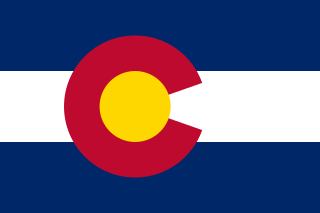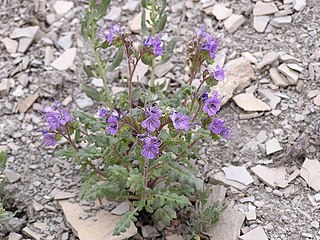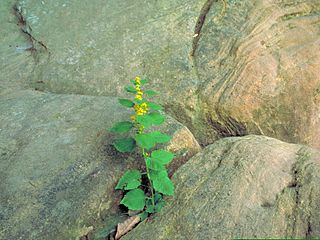| Phacelia submutica | |
|---|---|
 | |
| Scientific classification | |
| Kingdom: | Plantae |
| Clade: | Angiosperms |
| Clade: | Eudicots |
| Clade: | Asterids |
| Order: | Boraginales |
| Family: | Boraginaceae |
| Genus: | Phacelia |
| Species: | P. submutica |
| Binomial name | |
| Phacelia submutica J.T.Howell | |
Phacelia submutica is a rare species of flowering plant in the borage family known by the common name De Beque phacelia. It is endemic to Colorado in the United States, where it is limited to the Piceance Basin in two counties. It is threatened by petroleum exploration. It was federally listed as a threatened species of the United States on July 27, 2011, a ruling which took effect on August 26, 2011. [1]

Boraginaceae, the borage- or forget-me-notfamily, includes a variety of shrubs, trees, and herbs, totaling about 2,000 species in 146 genera found worldwide.

Endemism is the ecological state of a species being unique to a defined geographic location, such as an island, nation, country or other defined zone, or habitat type; organisms that are indigenous to a place are not endemic to it if they are also found elsewhere. The extreme opposite of endemism is cosmopolitan distribution. An alternative term for a species that is endemic is precinctive, which applies to species that are restricted to a defined geographical area.

Colorado is a state of the Western United States encompassing most of the southern Rocky Mountains as well as the northeastern portion of the Colorado Plateau and the western edge of the Great Plains. It is the 8th most extensive and 21st most populous U.S. state. The estimated population of Colorado was 5,695,564 on July 1, 2018, an increase of 13.25% since the 2010 United States Census.
This plant is sometimes treated as a variety of the more common Phacelia scopulina . [1] [2] [3] It was first collected in 1911 at De Beque, Colorado. It is an annual herb with a stem just a few centimeters long that lies flat on the ground, producing a small clump of leaves. The leaves are often reddish in color and measure up to 1.5 centimeters in length. They are covered in short, stiff hairs. The tiny tubular flowers are cream-colored or yellowish with a purple tinting. [3]
In botanical nomenclature, variety is a taxonomic rank below that of species and subspecies, but above that of form. As such, it gets a three-part infraspecific name. It is sometimes recommended that the subspecies rank should be used to recognize geographic distinctiveness, whereas the variety rank is appropriate if the taxon is seen throughout the geographic range of the species.

The Town of De Beque is a Statutory Town in Mesa County, Colorado, United States. It is part of the Grand Junction Metropolitan Statistical Area. The population was 504 at the 2010 census. The town consists of a small grid, including a historic downtown featuring a town hall, a tavern, and several commercial businesses in historic structures. The surrounding streets include houses, several churches, and a school.
The plant is known only from Garfield and Mesa Counties in western Colorado. There are 39 occurrences, but 13 have not been observed in over fifteen years. Population sizes are quite variable, and the plant can be locally common in some years depending on environmental conditions such as the amount of precipitation. It can be absent from an area one year and present the next year. This makes it difficult to estimate the current population. The plant grows in forest and woodland or shrubland habitat typically dominated by either Utah juniper or sagebrush. It grows on certain members of the Wasatch Formation where the soils support few other plant species. The phacelia does sometimes grow among pointed gumweed and Gordon’s buckwheat. [1]

Garfield County is one of the 64 counties in the U.S. state of Colorado. As of the 2010 census, the population was 56,389. The county seat is Glenwood Springs. The county is named in honor of United States President James A. Garfield.

Mesa County is one of the 64 counties of the U.S. state of Colorado. As of the 2010 census, the population was 146,723. The county seat is Grand Junction. The county was named for the many large mesas in the area, including Grand Mesa.

Juniperus osteosperma is a shrub or small tree reaching 3–6 m tall. It is native to the southwestern United States, in Utah, Nevada, Arizona, western New Mexico, western Colorado, Wyoming, southern Montana, southern Idaho and eastern California. It grows at moderate altitudes of 1,300–2,600 metres (4,300–8,500 ft), on dry soils, often together with Pinus monophylla.
This plant is threatened by several processes, especially natural gas development. Many occurrences are on land owned by the Bureau of Land Management, which leases it for gas extraction. Associated harmful activities include road construction and the installation of pipes and tanks. Other threats may include damage to the soil by livestock and competition from introduced species of plants. [1]

Natural gas, also called "Fossil Gas" is a naturally occurring hydrocarbon gas mixture consisting primarily of methane, but commonly including varying amounts of other higher alkanes, and sometimes a small percentage of carbon dioxide, nitrogen, hydrogen sulfide, or helium. It is formed when layers of decomposing plant and animal matter are exposed to intense heat and pressure under the surface of the Earth over millions of years. The energy that the plants originally obtained from the sun is stored in the form of chemical bonds in the gas.

The Bureau of Land Management (BLM) is an agency within the United States Department of the Interior that administers more than 247.3 million acres (1,001,000 km2) of public lands in the United States which constitutes one eighth of the landmass of the country. President Harry S. Truman created the BLM in 1946 by combining two existing agencies: the General Land Office and the Grazing Service. The agency manages the federal government's nearly 700 million acres (2,800,000 km2) of subsurface mineral estate located beneath federal, state and private lands severed from their surface rights by the Homestead Act of 1862. Most BLM public lands are located in these 12 western states: Alaska, Arizona, California, Colorado, Idaho, Montana, Nevada, New Mexico, Oregon, Utah, Washington and Wyoming.

Livestock is commonly defined as domesticated animals raised in an agricultural setting to produce labor and commodities such as meat, eggs, milk, fur, leather, and wool. The term is sometimes used to refer solely to those that are bred for consumption, while other times it refers only to farmed ruminants, such as cattle and goats. Horses are considered livestock in the United States. The USDA uses livestock similarly to some uses of the term “red meat”, in which it specifically refers to all the mammal animals kept in this setting to be used as commodities. The USDA mentions pork, veal, beef, and lamb are all classified as livestock and all livestock is considered to be red meats. Poultry and fish are not included in the category.

















